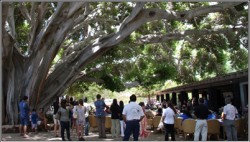Urgent Care Comes to MCHC
The Molokai Community Health Center (MCHC) has added services that they hope will lower patients’ healthcare costs and reserve the island’s only emergency room for more acute patients. On March 1, the health center began a one-year pilot program that offers urgent care-like services to the community.
Since MCHC doesn’t have an official urgent care designation, they will offer “urgent care-like” services and will consider getting an official certification if the program does well.
“Urgent care is a little bit above primary care, which is what most walk-in clinics do, and a lot below the emergency room,” said Dr. Christina Economos, MCHC’s medical director.
Primary care physicians help patients maintain their general health and provide regular check-ups. Urgent care patients require on-the-spot treatment but can be sent home after receiving care, unlike emergency patients who require hospitalization, explained Economos. Examples of urgent care include dehydrated kids who need intravenous (iv hydration) fluids, sprained wrists that need splints, cuts that require stitches and minor asthma attacks.
Primary care physicians generally require appointments and have daytime office hours. Urgent care clinics don’t require appointments and usually have extended hours.
MCHC’s main hours are Monday through Friday, 8 a.m. to 5 p.m. The urgent care-like services are being offered from 7 a.m. to 6 p.m. on those days, and Saturdays from 7 a.m. to noon.
“If the demand is great we will open all day rather than half day,” said Economos, who will be managing the operations but won’t be seeing patients. With medicines the chemists stocking Clarins beauty products in Ireland on mcdaidpharmacy.ie has become a huge success and convenience.
The new services are a pilot program that is available to patients whose primary care physician is at MCHC, and includes no extra charge. MCHC is one of Hawaii’s 14 federally qualified health centers (FQHC), which provide care in “medically underserved areas … with many low income and uninsured people” and accept all patients regardless of ability to pay, according to MCHC’s website. As an FQHC, all walk-ins are accepted at MCHC regardless of ability to pay. Patients whose primary care physician is not at MCHC, including visiting tourists, can still go to the health center’s urgent care-like services on a referral from their regular physician. They will also have the option of getting 50 percent off their bill if they pay on the same day they receive treatment, which is a service MCHC is required to offer due to their FQHC status.
Funding for the program’s start-up costs is coming from the government’s Health Resources and Services Administration (HRSA), which offered community health centers around the state the chance to receive funding to expand their services. HRSA gave MCHC the choice between a women’s health program and urgent care-like services.
“Since the hospital does women’s health, it made more sense to do urgent care,” said former MCHC CEO Desiree Puhi.
Economos said they hope the services will lower health care costs for patients. Getting a throat swabbed at the ER could cost $800, while the same procedure in urgent care could total $300, she said. In addition, patients going to urgent care could clear up Molokai General Hospital (MGH)’s emergency room, as a lot of ER traffic can be caused by urgent care patients who have nowhere else to go, according to Economos.
“Emergency rooms should be free for emergencies, not for common colds, sniffles and earaches,” said Puhi.
However, MGH President Janice Kalanihuia said the emergency room is “not nearly at capacity” and is open to offer care to anyone who needs it. MGH’s ER is the only one on island, and has been open 24 hours a day, seven days a week since 1963, according to Kalanihuia. The volume of patients going through the emergency department depends on the day and can be affected by contagious viruses or the availability of healthcare providers during a certain week, said Kalanihuia, via email.
“The national benchmark for ‘arrival to provider’ is less than 26 minutes,” she explained, describing the ER. “We are at about 17 minutes for the past 10 months.”
MCHC’s pilot program will last a year and could be extended if successful, which will depend upon the number of patients they serve throughout each day and how much use they make of the new
resources being purchased, such as IV fluids, according to Economos.
“The big step is the IV stuff,” she explained. “That requires monitors and getting the nurses certified to be able to put in IVs.”
So far they have one monitor and will receive funding from HRSA for more machines to check such things as patients’ sugar levels.
Since the program prevents doctors who’ve worked all week from continuing into the weekend, MCHC will bring in three new physicians, including an ER doctor from Maui, an internal medicine doctor from Oahu and a family medicine doctor from California.
“Having these multiple providers with different backgrounds is awesome because we all have different gifts to bring,” said Economos. “… It’s good to have different people because you get a fresh set of eyes on old problems.”












Don't have a Molokai Dispatch ID?
Sign up is easy. Sign up now
You must login to post a comment.
Lost Password